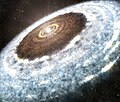V883 Orionis
Appearance
(Redirected from V883 Ori)
| Observation data Epoch J2000 Equinox J2000 | |
|---|---|
| Constellation | Orion |
| Right ascension | 05h 38m 18.102s[1] |
| Declination | −07° 02′ 26.02″[1] |
| Characteristics | |
| Variable type | FU Ori |
| Astrometry | |
| Proper motion (μ) | RA: −0.938[1] mas/yr Dec.: +1.490[1] mas/yr |
| Parallax (π) | 1.5259 ± 0.2923 mas[1] |
| Distance | 414[2] pc |
| Details | |
| Mass | 1.29±0.02[2] M☉ |
| Luminosity (bolometric) | 195[3] L☉ |
| Age | 0.5[2] Myr |
| Other designations | |
V883 Ori, HBC 489 | |
| Database references | |
| SIMBAD | data |
V883 Orionis is a protostar in the constellation of Orion. It is associated with IC 430 (Haro 13A), a peculiar Hα object surveyed by Guillermo Haro in 1952.[4] It is assumed to be a member of the Orion Nebula cluster at 414±7 pc.[2]
V883 Orionis, like most protostars, is surrounded by a circumstellar disc of dust. The dust has a water snow-line, a certain distance where the stellar irradiance from the star is low enough that water can freeze to snow. The water snow-line was directly imaged by ALMA, when a stellar outburst increased the amount of insolation and pushed the line out farther.[2] In 2023, it was announced that signs of water vapor had been detected in V883 Orionis' disc.[5]
Gallery
[edit]-
Artist's impression of the planet-forming disc around V883 Orionis
-
Informative video about the planet-forming disc around V883 Orionis
-
Artist's impression of the water snow line around V883 Orionis, detected with ALMA
-
IC 429 and IC 430 next to the bright foreground star 49 Ori. V883 Ori is the faint star just beyond the tip of IC 429.
-
V883 Ori (bright star) and part of IC 429 with the Hubble Space Telescope
References
[edit]- ^ a b c d e Vallenari, A.; et al. (Gaia collaboration) (2023). "Gaia Data Release 3. Summary of the content and survey properties". Astronomy and Astrophysics. 674: A1. arXiv:2208.00211. Bibcode:2023A&A...674A...1G. doi:10.1051/0004-6361/202243940. S2CID 244398875. Gaia DR3 record for this source at VizieR.
- ^ a b c d e Cieza, Lucas A.; et al. (2016). "Imaging the water snow-line during a protostellar outburst". Nature. 535 (7611): 258–261. arXiv:1607.03757. Bibcode:2016Natur.535..258C. doi:10.1038/nature18612. PMID 27411631. S2CID 205249709.
- ^ Furlan, E. (May 2016). "The Herschel Orion Protostar Survey: Spectral Energy Distributions and Fits Using a Grid of Protostellar Models". The Astrophysical Journal Supplement Series. 224 (1): 5. arXiv:1602.07314. Bibcode:2016ApJS..224....5F. doi:10.3847/0067-0049/224/1/5.
- ^ Allen, D. A.; Strom, K. M.; Grasdalen, G. L.; Strom, S. E.; Merrill, K. M. (1975). "Haro 13a: A Luminous, Heavily Obscured Star in Orion?". Monthly Notices of the Royal Astronomical Society. 173: 47P–50P. Bibcode:1975MNRAS.173P..47A. doi:10.1093/mnras/173.1.47P.
- ^ "Astronomers find missing link for water in the Solar System". ESO. 8 March 2023. Retrieved 21 March 2023.




